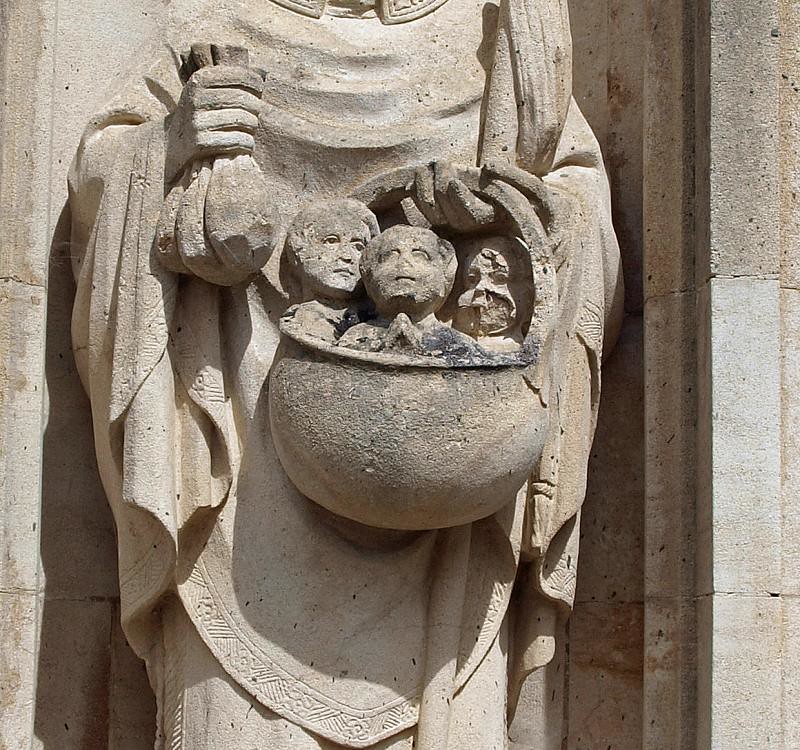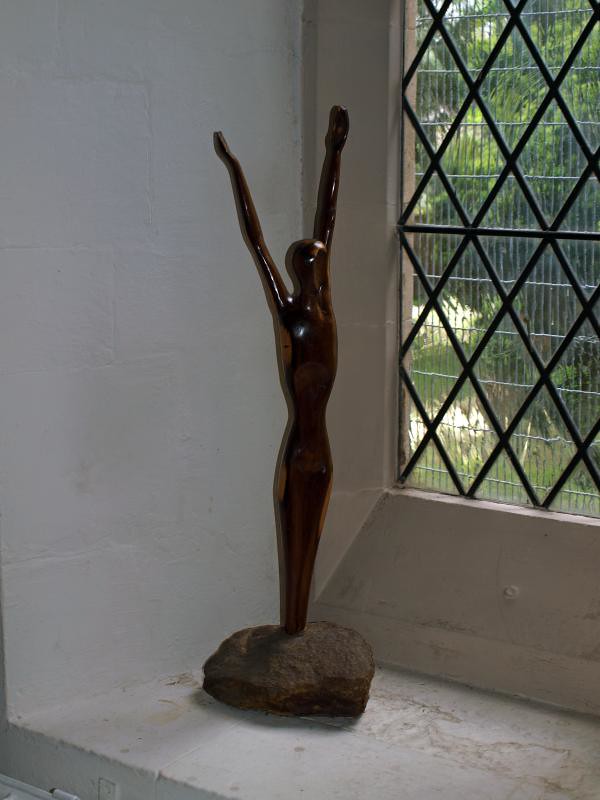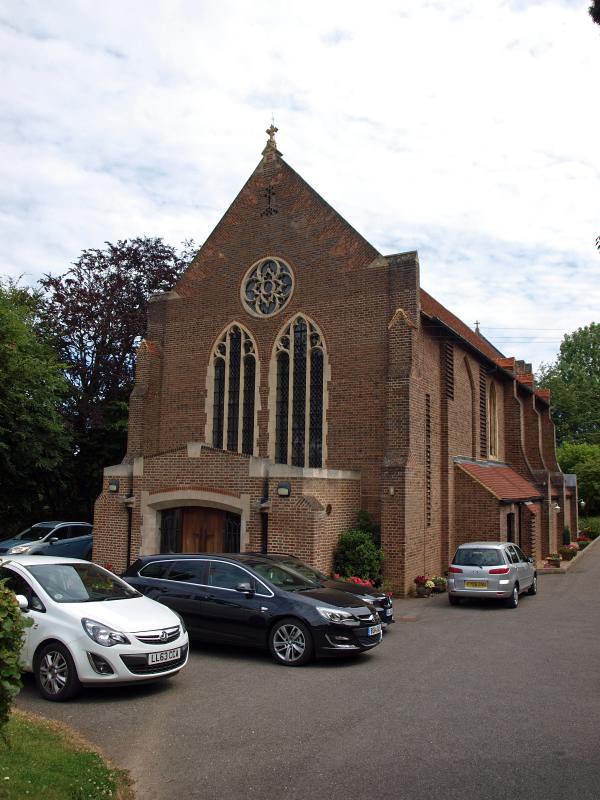Our Lady of Lourdes is, undeservedly in my opinion, treated perfunctorily by Pevsner (who also dates it incorrectly). Built in 1928/9 to the the Catholic architect A. F. Walters' designs this is a traditional Hertfordshire style church with some excellent furnishings - chancel and lady chapel reredoses for example - and good stained glass by T. H. (‘Harry’) Grylls of Burlison & Grylls and Arthur A. Orr and F. D. Humphreys and others. Also of note are the contemporaneous Stations of the Cross by Aloys de Buele (1861-1935). To my mind this is, for a Catholic church, a building of some merit. Taking Stock's entry can be found here.
St Nicholas is a Victorian rebuild but not a bad example of its kind. A predictably bland interior, almost all the monuments are repositioned in the C15th tower, contains two early Christopher Webb windows.
St John the Baptist is a run of the mill utilitarian 1908 Eden J. Hodgson build.
ST NICHOLAS, 1862 by W. Slater, except for the W tower (flint and stone, diagonal buttresses, SW stair-turret, spike). In the N aisle on window ledges C12 scalloped capital from the former chancel arch and C12 capital with upright stylized leaves. - FONT. c. 1200, polygonal bowl of Purbeck marble with two blank pointed arches on each panel. - MONUMENTS. Brass to William Anabull d. 1456 and wife, very decayed figures (close to pulpit). - Brass to William Cressye d. 1559 and wife, kneeling figures in stone surround (N transept wall; cf. Wheathampstead, Heyworth). - Godman Jenkyn d. 1746, standing wall monument with bulgy sarcophagus and obelisk with scrolly shield.
OUR LADY OF LOURDES, Rothamsted Avenue, 1905, by F. A. Walters.
Harpenden. It is the country town of great delight, unspoilt by the Industrial Age, with a touch of gold for ever on its gorse-clad common, lovely walks through woods and fields, trees in its streets, and an air as sweet and pure as any corner of the British Isles. Its very name means Valley of the Nightingales, and it is worthy of it.
It has little to tell us of history, but Nature has endowed it richly with her bounty - commons, woods, and No Man’s Land; streets like avenues, with roofs of houses peeping through the trees; and one of those broad High Streets that have come straight down from Old England, with a strip of green turf along the middle. In the heart of the village, just off the High Street by the green, stands the medieval tower of the church built with flint and stone in 1470. The church itself was new last century, but it has kept a few memorials from the ancient church, and the font at which Harpenden’s babies have been baptised since Norman days; it has a panelled bowl. There are brass portraits of two married couples, William Cressye and his wife in Tudor costume, and William and Isabella Annabull, worn out by being in the floor of the nave for about 500 years. A brass tablet pays tribute to a man who must have been delighted to make this country town his home, for he was one of the most painstaking students of Nature who ever lived, Richard Lydekker. Here he died in 1915, an immense loss to the science of Natural History, for he knew as much as any man about the structure of mammal, bird, and reptile, whether fossil or alive.
The churchyard slopes pleasantly with its limes and cypresses, and pines as high as the tower, and beyond are greens where pink chestnuts, may trees, and copper beeches flaunt themselves gaily as a background to a group of timbered cottages which have been here since Stuart days. On the outskirts of the town, at Hatching Green, is an inn with a Tudor rose and crown on its rough plaster front, and away towards Flamstead is Turner’s Hall with the date of 1665 somewhere about it and one wing 400 years old. The memorial to the men who did not come back is a cross on the green. A fitting place is Harpenden for natural research, and it has become the home of the greatest agricultural experimental station in the world. It is in the beautiful Rothamsted Park which lies beyond Harpenden Common, an old gabled house with medieval timbers and Tudor bricks. A great treasure of Rothamsted, discovered in 1940, is an ancient mural painting depicting the Earl of Hertford’s attack on Edinburgh in 1544., when the English were attempting to coerce the Scots into allowing Queen Mary to marry Prince Edward. The manor was then owned by the Bardolph family and doubtless one of them was a member of this expedition.
Rothamsted was the birthplace, in 1814., of Sir John Bennet Lawes, whose family took over the house in the early days of Charles I. He profited little at school or at Oxford, but, being of a purely scientific train of mind, he had a laboratory fitted up in a bedroom here and made himself a master of chemistry. At 21 he inherited the estate, and it happened that his attention was turned to the value of bones as a fertiliser of the soil, and prolonged experiments led him to set up a factory for the production of fertilisers, from which he derived much profit.
All the money he made he spent on his experiments for enriching the soil, and in time he came to develop food for cattle on new and revolutionary lines. He was laying the foundation of scientific agriculture, and men came from all over the world to look into his work. He studied various kinds of drainage, the varying results of fertilisers on different soils, and watched the evolution of new varieties of corn and vegetables. With a chemist friend, Sir Joseph Henry Gilbert, he brought about a great increase in the world’s daily bread. They divided the land at Rothamsted into special plots, and it may be said that nearly every improvement in fertilisers, in wheat selection, or in rotation of crops, was worked out here.
There is one plot here where wheat has been grown continuously since 1843. Lawes carried on his splendid work for more than 50 years, and his jubilee was honoured as that of a man famous throughout civilisation. He was a man of liberal mind, a social reformer, and took great interest in furnishing the village folk with allotments and amenities in those early days.
In order to ensure the future of his work Sir John founded the Rothamsted Trust, embracing the laboratory and 40 acres of land, and enriched with an endowment of £100,000. All over the world farmers are grateful to Rothamsted, and if that man has blessed his fellows who makes two blades of grass grow where one grew before, John Bennet Lawes must be counted among the incalculable benefactors of mankind. One thing we noticed which gives us an insight into the detail of the work at Rothamsted; we found a bright light shining at night, and discovered that it was meant to trap for examination the insects which play so great a part as friend or foe in agriculture. We were told that as many as 6000 have been caught in a single summer’s night.
It has little to tell us of history, but Nature has endowed it richly with her bounty - commons, woods, and No Man’s Land; streets like avenues, with roofs of houses peeping through the trees; and one of those broad High Streets that have come straight down from Old England, with a strip of green turf along the middle. In the heart of the village, just off the High Street by the green, stands the medieval tower of the church built with flint and stone in 1470. The church itself was new last century, but it has kept a few memorials from the ancient church, and the font at which Harpenden’s babies have been baptised since Norman days; it has a panelled bowl. There are brass portraits of two married couples, William Cressye and his wife in Tudor costume, and William and Isabella Annabull, worn out by being in the floor of the nave for about 500 years. A brass tablet pays tribute to a man who must have been delighted to make this country town his home, for he was one of the most painstaking students of Nature who ever lived, Richard Lydekker. Here he died in 1915, an immense loss to the science of Natural History, for he knew as much as any man about the structure of mammal, bird, and reptile, whether fossil or alive.
The churchyard slopes pleasantly with its limes and cypresses, and pines as high as the tower, and beyond are greens where pink chestnuts, may trees, and copper beeches flaunt themselves gaily as a background to a group of timbered cottages which have been here since Stuart days. On the outskirts of the town, at Hatching Green, is an inn with a Tudor rose and crown on its rough plaster front, and away towards Flamstead is Turner’s Hall with the date of 1665 somewhere about it and one wing 400 years old. The memorial to the men who did not come back is a cross on the green. A fitting place is Harpenden for natural research, and it has become the home of the greatest agricultural experimental station in the world. It is in the beautiful Rothamsted Park which lies beyond Harpenden Common, an old gabled house with medieval timbers and Tudor bricks. A great treasure of Rothamsted, discovered in 1940, is an ancient mural painting depicting the Earl of Hertford’s attack on Edinburgh in 1544., when the English were attempting to coerce the Scots into allowing Queen Mary to marry Prince Edward. The manor was then owned by the Bardolph family and doubtless one of them was a member of this expedition.
Rothamsted was the birthplace, in 1814., of Sir John Bennet Lawes, whose family took over the house in the early days of Charles I. He profited little at school or at Oxford, but, being of a purely scientific train of mind, he had a laboratory fitted up in a bedroom here and made himself a master of chemistry. At 21 he inherited the estate, and it happened that his attention was turned to the value of bones as a fertiliser of the soil, and prolonged experiments led him to set up a factory for the production of fertilisers, from which he derived much profit.
All the money he made he spent on his experiments for enriching the soil, and in time he came to develop food for cattle on new and revolutionary lines. He was laying the foundation of scientific agriculture, and men came from all over the world to look into his work. He studied various kinds of drainage, the varying results of fertilisers on different soils, and watched the evolution of new varieties of corn and vegetables. With a chemist friend, Sir Joseph Henry Gilbert, he brought about a great increase in the world’s daily bread. They divided the land at Rothamsted into special plots, and it may be said that nearly every improvement in fertilisers, in wheat selection, or in rotation of crops, was worked out here.
There is one plot here where wheat has been grown continuously since 1843. Lawes carried on his splendid work for more than 50 years, and his jubilee was honoured as that of a man famous throughout civilisation. He was a man of liberal mind, a social reformer, and took great interest in furnishing the village folk with allotments and amenities in those early days.
In order to ensure the future of his work Sir John founded the Rothamsted Trust, embracing the laboratory and 40 acres of land, and enriched with an endowment of £100,000. All over the world farmers are grateful to Rothamsted, and if that man has blessed his fellows who makes two blades of grass grow where one grew before, John Bennet Lawes must be counted among the incalculable benefactors of mankind. One thing we noticed which gives us an insight into the detail of the work at Rothamsted; we found a bright light shining at night, and discovered that it was meant to trap for examination the insects which play so great a part as friend or foe in agriculture. We were told that as many as 6000 have been caught in a single summer’s night.



No comments:
Post a Comment